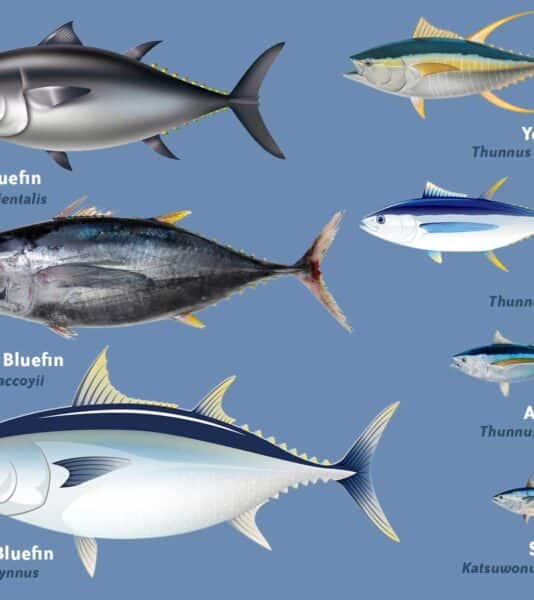Yes, tuna is good for you. It’s a protein powerhouse and contains heart-healthy omega-3 fatty acids, selenium, and vitamin D. All this with just 1 gram of fat and 130 calories per can.
PROTEIN TO BUILD HEALTHY MUSCLES, SKIN, AND BONES
Protein plays a vital role in essential bodily functions. Amino acids, the building blocks of proteins, contribute to bone, cartilage, skin, and muscle development. Ensuring sufficient protein intake is crucial for overall health. Additionally, lean proteins such as albacore tuna provide longer-lasting satiety compared to carbohydrates and fats. This makes it helpful for a weight loss diet. One can of albacore tuna in water contains 29 grams of high-quality protein. And, it’s complete protein, which means it has all nine amino acids that your body can’t produce itself.
OMEGA-3S TO SUPPORT A HEALTHY HEART
Albacore tuna, compared to other animal proteins like chicken and beef, is lower in fat. However, it stands out as an excellent source of a specific type of fat: omega-3 fatty acids. A diet rich in omega-3s is linked to reduced inflammation levels, lower blood triglycerides, and an overall decreased risk of heart disease. Enjoying fish, including canned albacore tuna, provides an easy and delicious way to reap the health benefits of omega-3s. Each serving of canned albacore tuna contains approximately 0.2 grams of omega-3s, contributing to about 15-20% of the adequate intake for adults according to the National Institutes of Health (NIH).
VITAMIN D TO KEEP YOUR BONES AND IMMUNE SYSTEM STRONG
Tuna is one of the few natural dietary sources of vitamin D. Adequate vitamin D is essential for bone health, immune function, and overall well-being. We can’t build or repair bones without calcium and we can’t absorb calcium without vitamin D. A 5-ounce can of tuna can contain up to 15% of the Daily Value for vitamin D
VITAMIN B-12 TO FUEL A HEALTHY METABOLISM AND RED BLOOD CELLS
Tuna is also rich in vitamin B-12, essential for vital functions like red blood cell and DNA production. A single can of albacore tuna provides slightly more than 2 micrograms of vitamin B-12, meeting the recommended daily amount for adults.
ESSENTIAL MINERALS TO PREVENT DEFICIENCIES FOR BETTER OVERALL HEALTH
Tuna contains crucial minerals such as selenium, potassium, and iron, which are vital for various physiological functions. Iron, particularly important during pregnancy due to increased red blood cell production for the growing fetus, can be boosted through dietary sources like tuna, or through supplements to enhance overall well-being.
WHAT ABOUT MERCURY AND SODIUM?
Some fish, like swordfish, tuna, and tilefish, can be contaminated with mercury content. The FDA states that the mercury levels in fish pose minimal risk to most individuals. Nevertheless, the FDA recommends that children between 1-11 years old and pregnant or breastfeeding women limit their tuna intake to no more than one serving (4 ounces) per week.
Tuna fish has a naturally low sodium (salt) content, but additional sodium is often included during the canning process. A 3-ounce serving may contain up to 22% of the recommended daily intake. If you’re monitoring your sodium intake, check the label carefully. Low-sodium or sodium-free options are also available for canned tuna.
TYPES OF TUNA
Most tuna that comes in a can or packet is sourced from skipjack, yellowfin, or albacore tuna. Light or chunk light tuna is typically skipjack and yellowfin tuna, but may also include tongol or bigeye tuna. Albacore, known for its light-colored flesh, firm texture, and mild flavor, is classified as white tuna, including solid white albacore and chunk white. Some individuals prefer albacore over light tuna varieties for dishes requiring a milder flavor and a firmer, more steak-like fish. Of all the types of tuna, the National Fisheries Institute reports that approximately 70% of canned and pouched tuna consumed by Americans is skipjack tuna (or a small amount of yellowfin), while about 30% is albacore.
COMPARING CANNED TUNA IN OLIVE OIL, TUNA IN WATER, AND FRESH TUNA
Now that we’ve compared types of fish, let’s look at the three main ways tuna is sold. As you can see below, all have favorable nutritional profiles and contain similar amounts of protein, vitamins, and minerals.
| (1 oz Portion) | Canned Tuna in Oil (Low Sodium) | Canned Tuna in Water (Low Sodium) | Fresh Raw Tuna (Boneless) |
|---|---|---|---|
| Protein | 8 grams | 6 grams | 7 grams |
| Omega-3s |
DHA: 29 mg EPA: 8 mg |
DHA: 56 mg EPA: 8 mg |
DHA: 25 mg EPA: 3 mg |
| Vitamin B-12 | 0.6 µg | 0.7 µg | 0.6 µg |
| Vitamin D | 1.9 µg | 0.3 µg | 0.5 µg |
| Iron | 0.4 mg | 0.5 mg | 0.2 mg |
| Selenium | 21.5 µg | 19 µg | 26 µg |
| Phosphorus | 88 mg | 39 mg | 79 mg |
| Potassium | 59 mg | 50 mg | 125 mg |
| Total Fat | 2.3 grams | 0.9 grams | 0.14 grams |
| Saturated Fat | 0.4 grams | 0.2 grams | 0.05 grams |
| Cholesterol | 5 mg | 10 mg | 11 mg |
| Sodium | 118 mg | 70 mg | 13 mg |
| Calories | 56 | 24 | 31 |
Frequently Asked Questions
Is canned tuna good for you?
Yes. Canned tuna is one of the most nutritious and affordable sources of protein available. And it features vitamins D and B-12, and minerals such as potassium and iron. Canned tuna also includes omega-3 fatty acids which support a healthy heart.
Is it okay to eat tuna fish everyday?
Eating tuna fish 2-3 times a week is a great way to vary your diet and enjoy all of the goodness that seafood has to offer, including vitamins, minerals and omega-3 fatty acids. The FDA recommends that children between 1-11 years old and pregnant or breastfeeding women limit their tuna intake to no more than one serving (4 ounces) per week.
Is tuna healthy with mayonnaise?
While tuna is generally considered a nutritious choice, tuna salad preparations often include excessive amounts of mayonnaise, significantly increasing calorie and fat intake. A single cup of mayo contains a staggering 1440 calories, 160 grams of fat, and 24 grams of saturated fat, along with nearly half of the recommended daily sodium intake.
Sources:
https://ods.od.nih.gov/factsheets/Omega3FattyAcids-HealthProfessional
https://fdc.nal.usda.gov/fdc-app.html#/?query=tuna
https://ods.od.nih.gov/factsheets/VitaminB12-HealthProfessional

WHERE TO BUY
Use our product locator to find the perfect salmon, tuna, crab or other seafood products from Chicken of the Sea.
- Products
- Choose Your Product
-
- Wild Caught Light Tuna in Spring Water Packet
- Wild Caught Light Tuna Packet, Lemon Garlic
- Wild Caught Light Tuna Packet, Sweet & Spicy
- Wild Caught Light Tuna Packet, Dill Tuna Salad
- Wild Caught Alaskan Pink Salmon in Spring Water Packet
- Wild Caught Alaskan Pink Salmon in Spring Water Packet, Low Sodium
- Wild Caught Alaskan Pink Salmon Packet, Everything Bagel Seasoning
- Wild Caught Alaskan Pink Salmon Packet, Lemon Pepper
- Wild Caught Smoked Alaskan Pink Salmon Packet, Maple Smokehouse Flavor
- Wild Caught Smoked Alaskan Pink Salmon Packet, Natural Wood Smoke
- Wild Caught Albacore Tuna in Spring Water Packet
- Wild Caught Chunk Light Tuna in Water
- Wild Caught Chunk Light Tuna in Water, 25% Less Sodium
- Wild Caught Chunk Light Tuna in Oil
- Wild Caught Solid White Premium Albacore Tuna in Water
- Wild Caught Solid White Premium Albacore Tuna in Oil
- Wild Caught Solid White Premium Albacore Tuna in Water, Low Sodium
- Wild Caught Alaskan Pink Salmon, Skinless & Boneless
- Wild Caught Alaskan Pink Salmon, 25% Less Sodium
- Wild Caught Sardines in Water
- Wild Caught Sardines in Olive Oil
- Whole Oysters
- Wild Caught Sardines in Oil, Lightly Smoked
- Imitation Crabmeat in Brine Packet
- Wild Caught Lump Crabmeat
- Wild Caught White Crabmeat
- Smoked Baby Clams in Oil Packet
- Crab Cakes
- Wild Caught Chub Mackerel in Brine
- Wild Caught Chopped Clams
- Whole Baby Clams
- Wild Caught Sardines in Louisiana Hot Sauce Packet
- Wild Caught Sardines in Mustard Sauce
- Wild Caught Mackerel Fillet in Oil Packet
- Wild Caught Mackerel in Oil Packet
- Wild Caught Sardines in Louisiana Hot Sauce
- Wild Caught Solid White Premium Albacore Tuna in Water, No Salt Added
- Perfectly Crisp Shrimp
- Crispy Stuffed Shrimp – Creamy Garlic & Spinach
- Wild Caught Chunk White Albacore Tuna in Water
- Crispy Stuffed Shrimp – Creamy Jalapeno
- Wild Caught Chunk White Albacore Tuna in Water, Low Sodium
- Wild Caught Chunk Yellowfin Tuna in Vegetable Oil
- Infusions Basil Tuna
- Infusions Lemon & Thyme Tuna
- Smoked Oysters in Oil Packet
- Infusions Thai Chili Tuna
- Fancy Smoked Oysters in Oil
- Wild Caught Sardines in Oil with Natural Smoke Flavor Packet
- Infusions Garlic & Herb Tuna
- Infusions Cracked Black Pepper Tuna
- To-Go Cups – Chunk Light Tuna in Water
- Wild Caught Sardines, Mediterranean Style
- Wild Caught Sardines in Lemon Sauce
- Wild Caught Alaskan Pink Salmon, Traditional Style
- Wild Caught Alaskan Sockeye Red Salmon, Traditional Style
- Wild Caught Pink Salmon with Lemon & Chive
- Blue Swimming Crab – Lump
- Blue Swimming Crab – Super Lump
- Blue Swimming Crab – Jumbo Lump
- Blue Swimming Crab – Backfin
- Blue Swimming Crab – Colossal
- Blue Swimming Crab – Claw
- Blue Swimming Crab – Special
- Raw Peeled & Deveined Tail-On Shrimp
- Raw Peeled & Deveined Tail-Off Shrimp
- Raw Shell On, Easy to Peel Shrimp
- Easy Grillers Uncooked Shrimp
- Cooked Peeled & Deveined Tail-On Shrimp
- Cooked Peeled & Deveined Tail-Off Shrimp
- Crispy Stuffed Shrimp – Creamy Wonton








